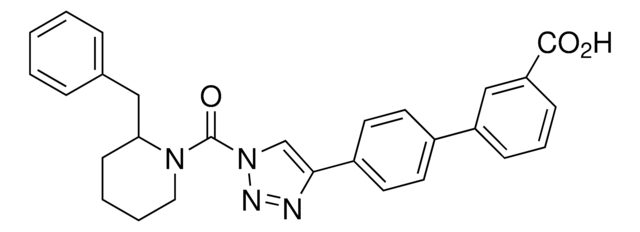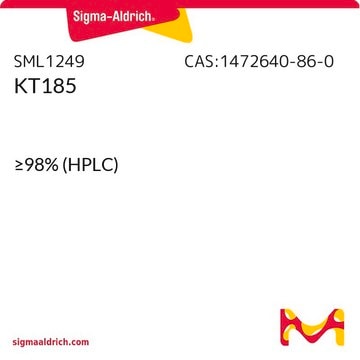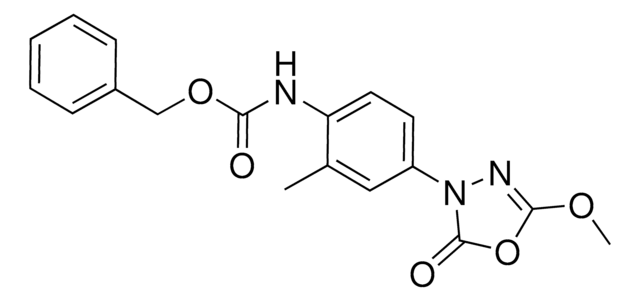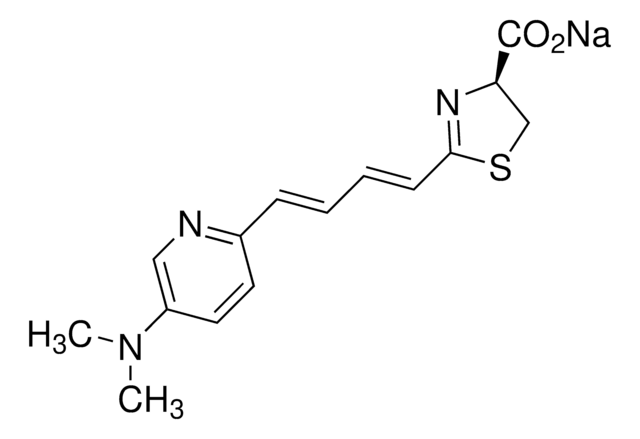추천 제품
분석
≥98% (HPLC)
형태
powder
색상
white to beige
solubility
DMSO: 10 mg/mL, clear
저장 온도
2-8°C
SMILES string
ClC1=CC=C(C(C2=CC=C(Cl)C=C2)N3CCN(C(OC(C(F)(F)F)C(F)(F)F)=O)CC3)C=C1
InChI
1S/C21H18Cl2F6N2O2/c22-15-5-1-13(2-6-15)17(14-3-7-16(23)8-4-14)30-9-11-31(12-10-30)19(32)33-18(20(24,25)26)21(27,28)29/h1-8,17-18H,9-12H2
InChI key
UPIHQFKOCOKGEO-UHFFFAOYSA-N
생화학적/생리학적 작용
특징 및 장점
Storage Class Code
11 - Combustible Solids
WGK
WGK 3
Flash Point (°F)
Not applicable
Flash Point (°C)
Not applicable
시험 성적서(COA)
제품의 로트/배치 번호를 입력하여 시험 성적서(COA)을 검색하십시오. 로트 및 배치 번호는 제품 라벨에 있는 ‘로트’ 또는 ‘배치’라는 용어 뒤에서 찾을 수 있습니다.
문서
신경과학을 위한 생체 활성 저분자
DISCOVER Bioactive Small Molecules for Neuroscience
관련 콘텐츠
The aim of the Cravatt research group is to understand the roles that mammalian enzymes play in physiological and pathological processes and to use this knowledge to identify novel therapeutic targets for the treatment of human disease. To achieve these goals, they develop and apply new technologies that bridge the fields of chemistry and biology, ascribing to the philosophy that the most significant biomedical problems require creative multidisciplinary approaches for their solution. The group's technological innovations address fundamental challenges in systems biology that are beyond the scope of contemporary methods. For instance, enzymes are tightly regulated by post-translational events in vivo, meaning that their activity may not correlate with expression as measured by standard genomic and proteomic approaches. Considering that it is an enzyme's activity, rather than abundance that ultimately dictates its role in cell physiology and pathology, the Cravatt group has introduced a set of proteomic technologies that directly measures this parameter. These activity-based protein profiling (ABPP) methods exploit the power of chemistry to engender new tools and assays for the global analysis of enzyme activities. The enzyme activity profiles generated by ABPP constitute unique molecular portraits of cells and tissues that illuminate how metabolic and signaling networks are regulated in vivo. Additionally, by evaluating enzymes based on functional properties rather than mere abundance, ABPP acquires high-content proteomic information that is enriched in novel markers and targets for the diagnosis and treatment of human disease.
자사의 과학자팀은 생명 과학, 재료 과학, 화학 합성, 크로마토그래피, 분석 및 기타 많은 영역을 포함한 모든 과학 분야에 경험이 있습니다..
고객지원팀으로 연락바랍니다.